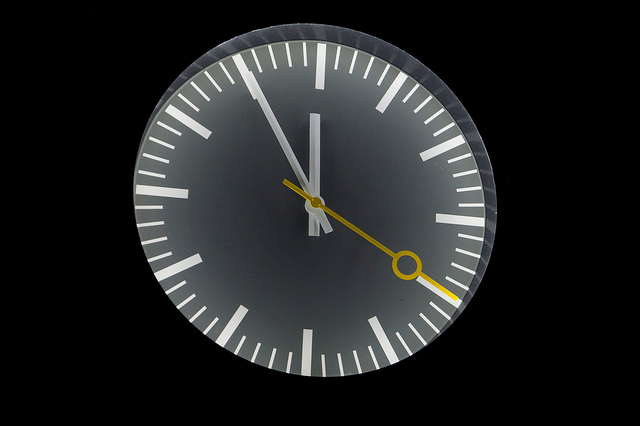
The next generation has good reason to be afraid: Representatives of the Bulletin of Atomic Scientists have just reset the iconic Doomsday Clock, bringing us even closer to midnight. At the toll of the bell, they warn, the globe faces apocalypse — and while the clock above is set at five minutes to twelve, that’s so 2012. This month, they jumped the clock ahead by two minutes, to three minutes to midnight. If we don’t do something soon, they warn, we may be facing an ugly future.
Researchers first developed the Doomsday Clock in 1947, initially as a metaphor for the risk of nuclear war. The Science and Security Board of the Bulletin of Atomic Scientists is responsible for maintaining it, with a board of consultants that meets twice annually to determine if the clock should be advanced, rewound, or left as it is. 60 years later, the organization added concerns about climate change and other environmental factors to their calculations in order to generate a more accurate reflection of global conditions.
1953 marked the Doomsday Clock’s nadir, when the clock stood at just one minute to midnight in response to nuclear testing conducted by both the United States and Russia. It served as a sober warning that if both nations didn’t cooperate to develop a more friendly relationship, they might annihilate each other and pose significant risks for the rest of the globe. In the following years, the clock moved back and forth to reflect long-term trends observed by members of the board that met to determine whether to reset the clock. By 1991, the landscape had shifted, with the fall of the Soviet Union and a more open political climate leading to a decision to wind the clock all way back to 17 minutes to midnight.
Since 1991, however, the clock has been pushing inexorably towards midnight, and the recent decision marks an ominous moment. The organization declares that it’s concerned with two factors that may be pushing the globe towards a crisis point. One hearkens back to the origins of the clock: Nuclear arsenals. Despite repeated and systemic attempts to get the world to cooperate on destroying nuclear arsenals and securing remaining nuclear material, countries like the United States and Russia are still clinging to nuclear munitions and escalating political tensions pose a significant global threat.
Researchers are also frustrated by inaction on climate change. Numerous global conferences on the subject have failed to achieve meaningful policy and change, though some nations are moving toward implementation of emissions reduction and other measures to reduce their ecological footprints. Overall, however, the global climate is shifting and big players on the global stage, like the United States, appear reluctant to take a regulatory role and a global lead in addressing the issue. Moving the clock forward is a stark reminder that the world is running out of time unless the international community can act swiftly on the issue.
The clock is not intended to act as a literal countdown to doomsday. Rather, it’s a symbolic representation of the political situation on Earth and how it may influence our future prospects of survival. The closer it moves to midnight, the more imperative it is that we act. The further away we move, the better we’re doing at addressing issues of concern to build a more stable world to pass on to future generations. It’s worrying that the clock hasn’t moved backward since 1991, a sign that we are engaged in a dangerous progression towards another breaking point like 1953.
Join us in defending the truth before it’s too late
The future of independent journalism is uncertain, and the consequences of losing it are too grave to ignore. To ensure Truthout remains safe, strong, and free, we need to raise $46,000 in the next 7 days. Every dollar raised goes directly toward the costs of producing news you can trust.
Please give what you can — because by supporting us with a tax-deductible donation, you’re not just preserving a source of news, you’re helping to safeguard what’s left of our democracy.